市场营销第十一章中英双语知识点总结
- 格式:docx
- 大小:17.73 KB
- 文档页数:5

市场营销学各章节知识点汇总一、1、理解市场及其相关概念(见课件:市场是发展的动态概念。
1经济学的市场观:a市场是商品交换的场所;b市场是商品交换流通的领域;c市场是商品供求关系的总和;2管理学的市场观3企业的市场观)2、市场营销学产生的时间(1900年)、国家(美国),美国市场营销协会的简称AMA. 3、市场营销学的性质(学科性质:市场营销学是一门建立在经济科学、行为科学和现代管理理论基础上的应用科学)、研究对象(主体,客体与环境)4、掌握市场营销的定义(菲利普·科特勒的定义:市场营销是指个人和群体通过创造,并同他人交换产品和价值以满足需求和欲望的一种社会管理过程)p10 5、理解市场营销的含义以及相关概念(需要{指消费者的生理及心理需求}、欲望{指想得到基本需求的具体满足物的愿望}、需求{指对有能力购买并且有愿意购买某个具体产品的欲望}、交换{指从他人处取得所需之物,而以某些东西作为回报的行为}、交易{是交换活动的基本单元,是由双方之间的价值交换所构成的行为}、效用{指产品满足人们欲望的能力})的内涵p8-9,理解市场营销者既可以是卖方,也可以是买方(市场营销者是指从事市场营销活动的人,它既可以是卖方也可以是买方,作为买方,他力图在市场上推销自己,以获取卖者的青睐,这样买方是在进行市场营销。
作为卖方,他努力在市场上推销自己的产品,以获取买者的青睐,这样卖方是在进行市场营销。
)。
P10 6、交换满足的5个条件(1、至少有交换双方;2每一方都有对方需要的有价值的东西;3每一方都能沟通信息和传送物品;4每一方都有接受或拒绝对方供应品的自由;5参与一方要有于另一方交往的欲望)7、理解营销起点是顾客需求,终点是顾客满意(首先从营销概念来说,营销是通过一系列复杂的研发、生产产品和交换产品价值,从而使个人和群体的欲望得到满足的一种经济活动的过程;其次,在所有营销活动中,顾客需求才是企业发展的源头,顾客因为需求就要发生交换行为,也就产生了交易购买,这是营销的起点;实现企业的利益最大化,顾客价值的最大化,以及社会利益的最大化都在这一环节中体现,所以如何实现顾客价值的最大化,让顾客的期望得到实现,从而达到让顾客满意称为关键,这是营销的终点);交换是营销的核心职能(产品只有通过交换才能使市场营销产生,所以交换是先于市场营销的基础性概念,是市场营销的核心职能)二、1、掌握市场营销管理的概念(市场营销管理是指企业为实现其目标,创造建立并保持与目标市场之间的互利交换关系而进行的分析,计划,执行与控制的过程)、实质(需求管理)。
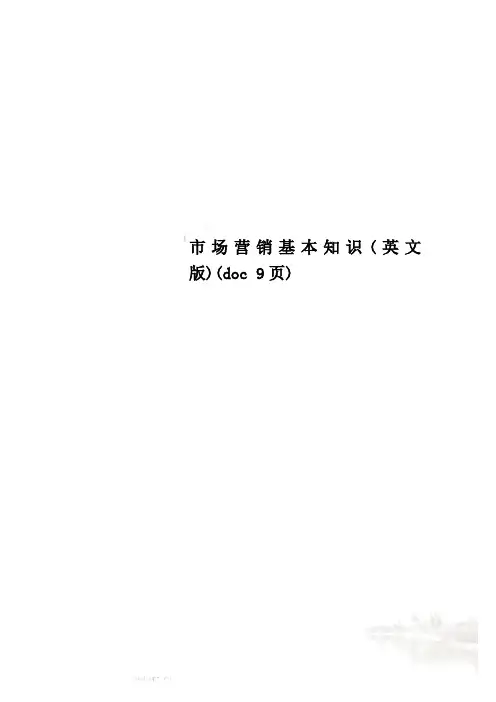
市场营销基本知识(英文版)(doc 9页)更多企业学院:《中小企业管理全能版》183套讲座+89700份资料《总经理、高层管理》49套讲座+16388份资料《中层管理学院》46套讲座+6020份资料《国学智慧、易经》46套讲座《人力资源学院》56套讲座+27123份资料《各阶段员工培训学院》77套讲座+ 324份资料《员工管理企业学院》67套讲座+ 8720份资料《工厂生产管理学院》52套讲座+ 13920份资料《财务管理学院》53套讲座+ 17945份资料《销售经理学院》56套讲座+ 14350份资料《销售人员培训学院》72套讲座+ 4879份资料更多企业学院:《中小企业管理全能版》183套讲座+89700份资料《总经理、高层管理》49套讲座+16388份资料《中层管理学院》46套讲座+6020份资料《国学智慧、易经》46套讲座《人力资源学院》56套讲座+27123份资料《各阶段员工培训学院》77套讲座+ 324份资料《员工管理企业学院》67套讲座+ 8720份资料《工厂生产管理学院》52套讲座+ 13920份资料《财务管理学院》53套讲座+ 17945份资料《销售经理学院》56套讲座+ 14350份资料《销售人员培训学院》72套讲座+ 4879份资料1.Please draw the pyramid of Maslow’s hierarchy of needs and try toillustrate.A person tries to satisfy the most important need first. When that need issatisfied, it will stop being a motivator and the person will then try to satisfy the next most important need.Physiological needs, they consist of need for oxygen, food, water, and a relatively constant temperature.Safety needs, when all physiological needs are satisfied, the need for security can become active. Adult have little awareness of their security needs except in times of emergency or periods of widespread rioting(暴动). Children often display the signs of insecurity and the need to be safe.Social needs, when the needs for safety and for physiological are satisfied, the need for love, affection, and belongingness can emerge. People seek to overcome feelings of loneliness and alienation(疏离). This involves both giving and receiving love, affection and the sense of belonging.Esteem needs, when above three needs are satisfied; the needs for esteem can become dominant. These involve needs for both self-esteem and for the esteem a person gets from others.Self-actualization needs, when all of the foregoing(上面提到的) needs are satisfied, then the need for self-actualization activated. Self-actualization as a person’s need to be and do that the person was “born to do”. These needs make themselves felt in signs of restless, because they don’t know what restlessness(坐立不安)is about.2.What is the PEST analysis?A PEST analysis of the company’s microenvironments factors will be madein this section. PEST analysis involves identifying the political, economical, social and technological influences on an organization.P—political environmentE—economical environmentS—socio cultural environmentT—technological environmente an example to explain three levels of benefits in terms of productanalysis.A Parker fountain pen, the product analysis would be:Core Benefit, Writing implement for communicationReal Product, A physical fountain penEnhanced Product, Brand identity, guarantee period, repair and maintenance service4.What’s PLC? (产品生产周期)A product’s lifecycle can be divided into four stages.Introduction stage is a period of slow sales growth as the product being introduce in the market; this is the most expensive stage.Growth stage is a period of rapid market acceptance and increasing profiles.The product is establishing itself in the market and sales are increasing over time.Maturity stage is a period of slowdown in sales growth, because the product has achieved acceptance by most potential buyers.Decline stage is a period when sales fall off and profit drop.周期表表示的是随着时间的增长,销量产生的变化。
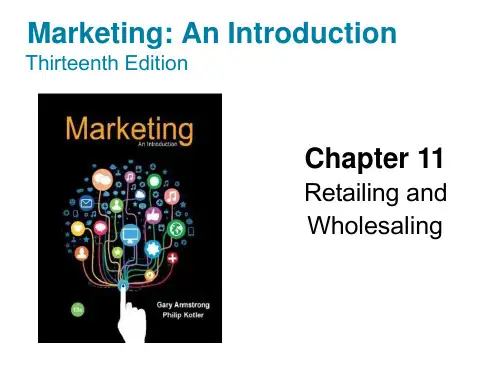
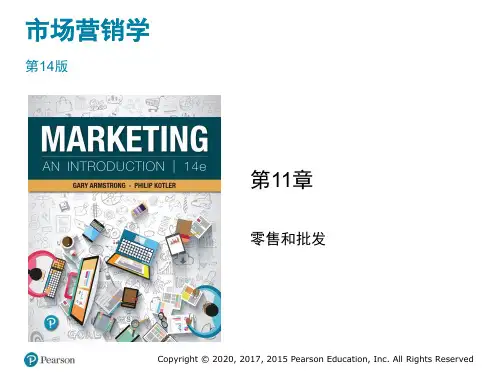
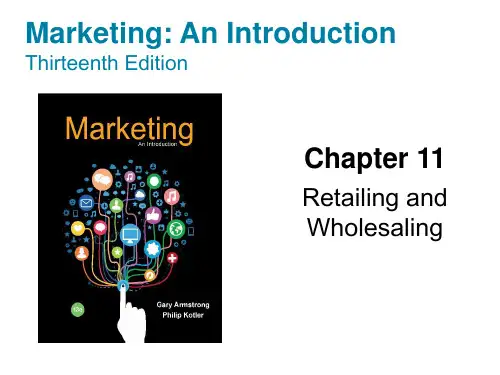
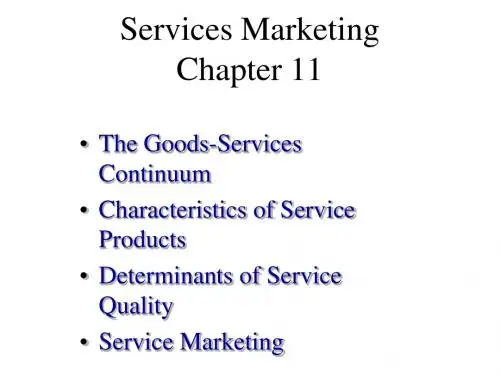
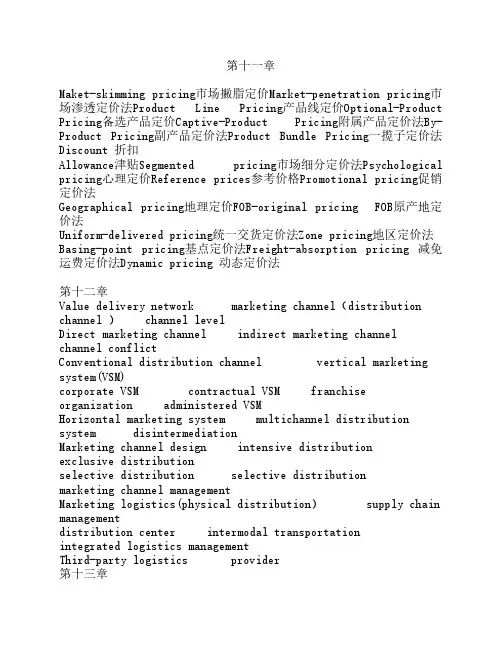
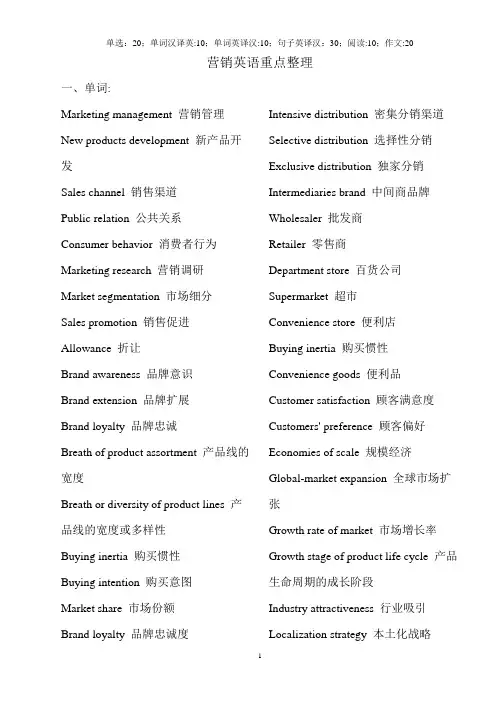
单选:20;单词汉译英:10;单词英译汉:10;句子英译汉:30;阅读:10;作文:20营销英语重点整理一、单词:Marketing management 营销管理New products development 新产品开发Sales channel 销售渠道Public relation 公共关系Consumer behavior 消费者行为Marketing research 营销调研Market segmentation 市场细分Sales promotion 销售促进Allowance 折让Brand awareness 品牌意识Brand extension 品牌扩展Brand loyalty 品牌忠诚Breath of product assortment 产品线的宽度Breath or diversity of product lines 产品线的宽度或多样性Buying inertia购买惯性Buying intention 购买意图Market share 市场份额Brand loyalty 品牌忠诚度Intensive distribution 密集分销渠道Selective distribution 选择性分销Exclusive distribution 独家分销Intermediaries brand 中间商品牌Wholesaler 批发商Retailer 零售商Department store 百货公司Supermarket 超市Convenience store 便利店Buying inertia 购买惯性Convenience goods 便利品Customer satisfaction 顾客满意度Customers' preference 顾客偏好Economies of scale 规模经济Global-market expansion 全球市场扩张Growth rate of market 市场增长率Growth stage of product life cycle 产品生命周期的成长阶段Industry attractiveness 行业吸引Localization strategy 本土化战略Comparative advertisements 比较广告Competition-orientated pricing 竞争导向定价法Customer—orientated pricing 顾客导向定价法Personal selling 人员销售Advertising strategies 广告策略Public relation 公共关系Marketing research 营销调研Product strategy 产品策略Product mix 产品组合The marketing concept 营销观念Consumer market 消费者市场Customer satisfaction 顾客满意Total customer value 顾客总价值Marketing environment 营销环境Market segmentation strategy 市场细分策略Market targeting strategy 目标市场策略Market positioning strategy 市场定位策略Product life cycle 产品市场寿命周期The selling /sales concept 销售观念The product concept 产品观念Marketing management philosophy 市场营销观念Societal marketing concept 社会营销观念Macro-marketing environment 宏观营销环境Product mix 产品组合Customer loyalty 顾客忠诚度Market targeting 目标市场选择Niche—market strategy 利基市场战略Personal selling 人员推销Price discrimination 价格歧视Potential customer 潜在顾客Potential market 潜在市场Product development 产品开发Product positioning 产品定位Segmentation criteria 细分标准Specialty goods 特殊产品二、句子:1、The societal marketing concept holds that the organization should determine the needs,wants,and interests of target markets。
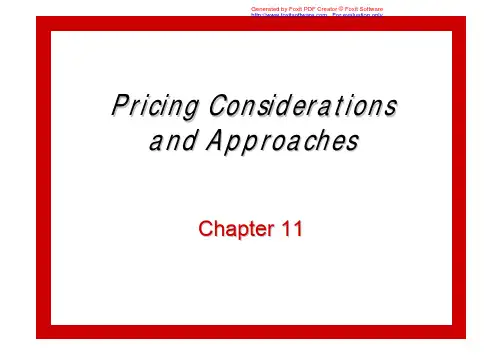
Pricing Considerations and ApproachesChapter 11Objectives •Understand the internal factors affecting a firm’s pricing decisions.•Understand the external factors affecting pricing decisions, including the impact of consumer perceptions of price and value.•Be able to contrast the three general approaches to setting prices.•“Buyer-driven commerce”concept offers lower prices to consumers and the ability to sell excess inventory to sellers •13.5 million user customer base •Tremendous growth •Most deals relate to travel or time sensitive / perishable services•Not all ventures have been profitable •Some customers find it difficult to commit to purchase prior to learning details Case StudyPrice Has Many Names What is Price?•Rent•Fee•Rate •Commission •Assessment •Tuition•Fare•Toll•Premium •Retainer•Bribe•Salary•Wage•Interest•TaxDefinition•Price§The amount of money charged for aproduct or service, or the sum of thevalues that consumers exchange forthe benefits of having or using theproduct or service.What is Price?•Dynamic Pricing on the Web allows SELLERS to:§Charge lower prices, reap higher margins.§Monitor customer behavior and tailoroffers.§Change prices on the fly to adjust forchanges in demand or costs.§Negotiate prices in online auctions andexchanges.What is Price?•Dynamic Pricing on the Web allows BUYERS to:§Get instant price comparisons fromthousands of vendors.§Find and negotiate lower prices.§Negotiate prices in online auctionsand exchanges.What is Price?•Price and the Marketing Mix:§Only element to produce revenues §Most flexible element§Can be changed quickly•Price Competition•Common Pricing Mistakes•Cost -Based Pricing: Cost -Plus Pricing§Adding a standard markup to cost §Ignores demand and competition §Popular pricing technique because:vIt simplifies the pricing processv Price competition may be minimizedv It is perceived as more fair to both buyers and sellersGeneral Pricing ApproachesGeneral PricingApproachesCost-Based Pricing ExampleVariable costs: $20 Fixed costs: $ 500,000 Expected sales: 100,000 units Desired Sales Markup: 20%Variable Cost + Fixed Costs/Unit Sales = Unit Cost$20 + $500,000/100,000 = $25 per unitUnit Cost/(1 –Desired Return on Sales) = Markup Price$25 / (1 -.20) = $31.25General PricingApproaches•Cost-Based Pricing: Break-Even Analysis and Target Profit Pricing§Break-even charts show total cost andtotal revenues at different levels of unitvolume.§The intersection of the total revenue andtotal cost curves is the break-even point.§Companies wishing to make a profit mustexceed the break-even unit volume.•Value -Based Pricing:§Uses buyers ’perceptions of value rather than seller ’s costs to set price.§Measuring perceived value can be difficult.§Consumer attitudes toward price andquality have shifted during the last decade.v Introduction of less expensive versions ofestablished brands has become common.General Pricing Approaches•Value -Based Pricing:§Business -to -business firms seek to retainpricing powerv Value -added strategies can help§Value pricing at the retail level vEveryday low pricing (EDLP) vs. high -lowpricingGeneral PricingApproachesGeneral PricingApproaches•Competition-Based Pricing:§Also called going-rate pricing§May price at the same level, above, orbelow the competition§Bidding for jobs is another variation ofcompetition-based pricingv Sealed bid pricing。

Chapter 1 The Scope and Challenge of International Marketing第一章国际市场营销学的范围和挑战1. MarketingMarketing: the process of building lasting relationships through planning, executing and controlling the conception, pricing, promotion and distribution of ideas, goods and services to create mutual exchange that satisfy individual and organizational needs and objectives.营销是个人和集体通过创造,提供出售,并同他人交换产品和价值,已获得其所需所欲之物的一种社会和管理过程。
Marketing and salesMarketing is the process of seeking to uncover consumers’requirements and adopting the information to product’ distribution and promotion.Sale is to sell what that has already been produced to customers without thinking of the customers’ needs and wants.2. Basic elements of the marketing concept⑴Needs: is a state of deprivation of some basic satisfaction.需求是指没有得到某些基本满足的感受状态。
Physical needs for food, clothing, warmthSocial needs for belonging, respect and affectionIndividual needs for knowledge and self-expression(2)Wants: are devices for specific items that can satisfy those needs.欲望是指对具体满足物的愿望。

第一二章1. 需要、欲望和需求需要(Needs) :没有得到某些满足的感受和状态。
欲望(Wants):想消除未满足的状态,得到某种具体满足物的愿望。
需求(Demands):有购买力并愿意购买某个具体产品的欲望。
Demands 的两个条件:具有购买能力(支付能力);愿意购买2.效用、费用和满足效用 (Utility):由产品提供的各种功能。
费用 (Cost) :得到产品效用所需要的成本付出。
(含购买成本和使用成本)满足(Satisfaction) :消费者通过使用产品对其效用和费用的综合评价而形成的一种心理状态。
(与消费者的期望值有关)顾客让渡价值=总顾客价值-总顾客成本3.交换、交易交换(Exchange):有价值的东西的相互转移。
交易(Transaction):一定条件(协议)下的交换行为;4.关系和网络关系(Relations):交易双方或多方所形成的相关联系的状态。
关系营销(Relationship Marketing):是指企业与关键成员,包括顾客、供应商、分销商建立长期满意关系的实践。
其中,与顾客建立长期合作关系是关系营销的核心内容。
5.营销等于推销?菲利普·科特勒指出,推销只是市场营销冰山上的一角,推销不是市场营销的最重要的职能。
这是因为,如果企业的市场营销人员搞好市场营销研究,了解购买者的需要,按照购买者的需要来设计和生产适销对路的产品,同时合理定价,搞好分销、促销等市场营销工作,那么这些产品就能轻而易举地推销出去。
彼得·德鲁克说,市场营销的目的在于使推销成为多余。
6.国际市场营销学与市场营销学的关系①、相同点:国际市场营销学是基础市场营销学的一个分支,是基础市场营销学的延伸和分支。
国际市场营销学的基本原理和方法同基础市场营销学无多大差异②、不同点:(1 )市场营销环境不同;(2 )市场营销组合策略有区别;(3 )国际营销战略及营销管理过程更复杂。
7.国际市场营销与国际贸易的比较①、国际贸易与国际营销的共同点A.目的相同:两者都是以国际市场为活动场所;都是以获得利润收入为目的而进行的超越国界的经济活动;B.交换对象相同:商品或劳务;环境相同:国际环境;理论基础相同:比较利益学说及国际产品生命周期理论这两种经济活动②、国际贸易与国际营销的主要区别A.商品交换的主体不同:B.商品流通形态不同:国际贸易的产品和服务,其交换必须是超越国界的,国际市场营销则是指经济活动超越国界,而不是产品和服务必须超越国界。